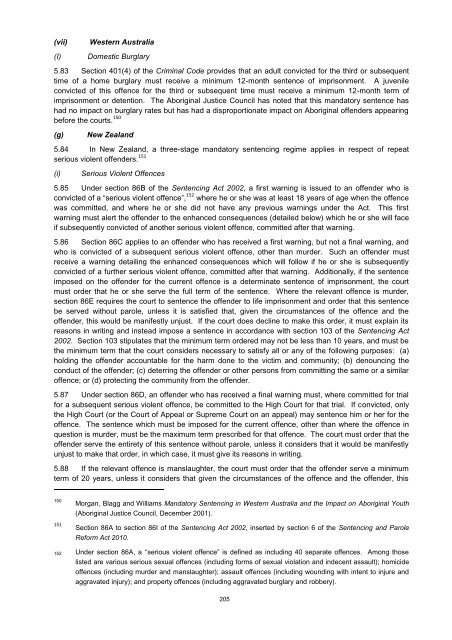Report on Mandatory Sentences - Law Reform Commission
Report on Mandatory Sentences - Law Reform Commission
Report on Mandatory Sentences - Law Reform Commission
Create successful ePaper yourself
Turn your PDF publications into a flip-book with our unique Google optimized e-Paper software.
(vii)<br />
(I)<br />
Western Australia<br />
Domestic Burglary<br />
5.83 Secti<strong>on</strong> 401(4) of the Criminal Code provides that an adult c<strong>on</strong>victed for the third or subsequent<br />
time of a home burglary must receive a minimum 12-m<strong>on</strong>th sentence of impris<strong>on</strong>ment. A juvenile<br />
c<strong>on</strong>victed of this offence for the third or subsequent time must receive a minimum 12-m<strong>on</strong>th term of<br />
impris<strong>on</strong>ment or detenti<strong>on</strong>. The Aboriginal Justice Council has noted that this mandatory sentence has<br />
had no impact <strong>on</strong> burglary rates but has had a disproporti<strong>on</strong>ate impact <strong>on</strong> Aboriginal offenders appearing<br />
before the courts. 150<br />
(g)<br />
New Zealand<br />
5.84 In New Zealand, a three-stage mandatory sentencing regime applies in respect of repeat<br />
serious violent offenders. 151<br />
(i)<br />
Serious Violent Offences<br />
5.85 Under secti<strong>on</strong> 86B of the Sentencing Act 2002, a first warning is issued to an offender who is<br />
c<strong>on</strong>victed of a “serious violent offence”, 152 where he or she was at least 18 years of age when the offence<br />
was committed, and where he or she did not have any previous warnings under the Act. This first<br />
warning must alert the offender to the enhanced c<strong>on</strong>sequences (detailed below) which he or she will face<br />
if subsequently c<strong>on</strong>victed of another serious violent offence, committed after that warning.<br />
5.86 Secti<strong>on</strong> 86C applies to an offender who has received a first warning, but not a final warning, and<br />
who is c<strong>on</strong>victed of a subsequent serious violent offence, other than murder. Such an offender must<br />
receive a warning detailing the enhanced c<strong>on</strong>sequences which will follow if he or she is subsequently<br />
c<strong>on</strong>victed of a further serious violent offence, committed after that warning. Additi<strong>on</strong>ally, if the sentence<br />
imposed <strong>on</strong> the offender for the current offence is a determinate sentence of impris<strong>on</strong>ment, the court<br />
must order that he or she serve the full term of the sentence. Where the relevant offence is murder,<br />
secti<strong>on</strong> 86E requires the court to sentence the offender to life impris<strong>on</strong>ment and order that this sentence<br />
be served without parole, unless it is satisfied that, given the circumstances of the offence and the<br />
offender, this would be manifestly unjust. If the court does decline to make this order, it must explain its<br />
reas<strong>on</strong>s in writing and instead impose a sentence in accordance with secti<strong>on</strong> 103 of the Sentencing Act<br />
2002. Secti<strong>on</strong> 103 stipulates that the minimum term ordered may not be less than 10 years, and must be<br />
the minimum term that the court c<strong>on</strong>siders necessary to satisfy all or any of the following purposes: (a)<br />
holding the offender accountable for the harm d<strong>on</strong>e to the victim and community; (b) denouncing the<br />
c<strong>on</strong>duct of the offender; (c) deterring the offender or other pers<strong>on</strong>s from committing the same or a similar<br />
offence; or (d) protecting the community from the offender.<br />
5.87 Under secti<strong>on</strong> 86D, an offender who has received a final warning must, where committed for trial<br />
for a subsequent serious violent offence, be committed to the High Court for that trial. If c<strong>on</strong>victed, <strong>on</strong>ly<br />
the High Court (or the Court of Appeal or Supreme Court <strong>on</strong> an appeal) may sentence him or her for the<br />
offence. The sentence which must be imposed for the current offence, other than where the offence in<br />
questi<strong>on</strong> is murder, must be the maximum term prescribed for that offence. The court must order that the<br />
offender serve the entirety of this sentence without parole, unless it c<strong>on</strong>siders that it would be manifestly<br />
unjust to make that order, in which case, it must give its reas<strong>on</strong>s in writing.<br />
5.88 If the relevant offence is manslaughter, the court must order that the offender serve a minimum<br />
term of 20 years, unless it c<strong>on</strong>siders that given the circumstances of the offence and the offender, this<br />
150<br />
151<br />
Morgan, Blagg and Williams <strong>Mandatory</strong> Sentencing in Western Australia and the Impact <strong>on</strong> Aboriginal Youth<br />
(Aboriginal Justice Council, December 2001).<br />
Secti<strong>on</strong> 86A to secti<strong>on</strong> 86I of the Sentencing Act 2002, inserted by secti<strong>on</strong> 6 of the Sentencing and Parole<br />
<strong>Reform</strong> Act 2010.<br />
152 Under secti<strong>on</strong> 86A, a “serious violent offence” is defined as including 40 separate offences. Am<strong>on</strong>g those<br />
listed are various serious sexual offences (including forms of sexual violati<strong>on</strong> and indecent assault); homicide<br />
offences (including murder and manslaughter); assault offences (including wounding with intent to injure and<br />
aggravated injury); and property offences (including aggravated burglary and robbery).<br />
205
















